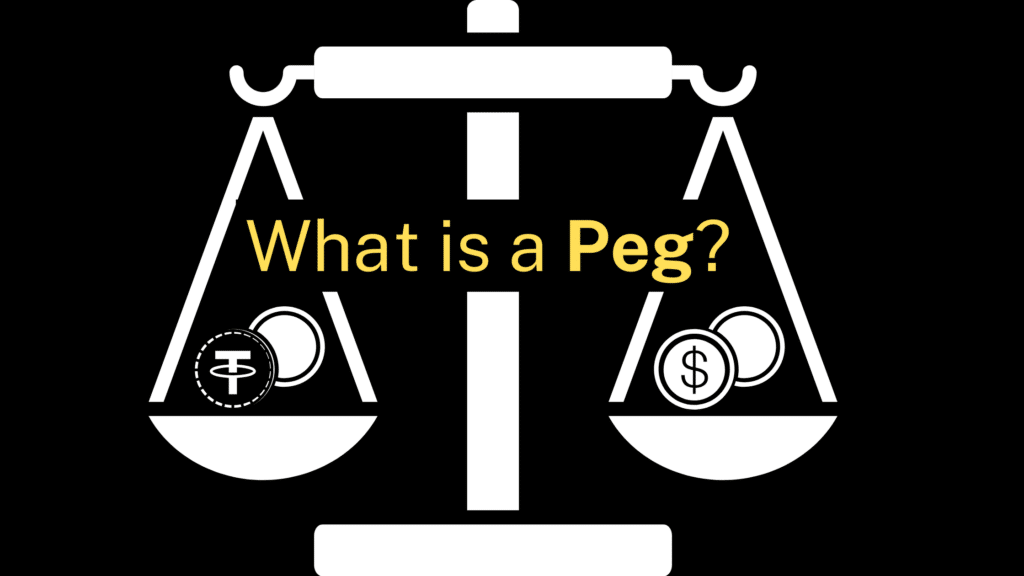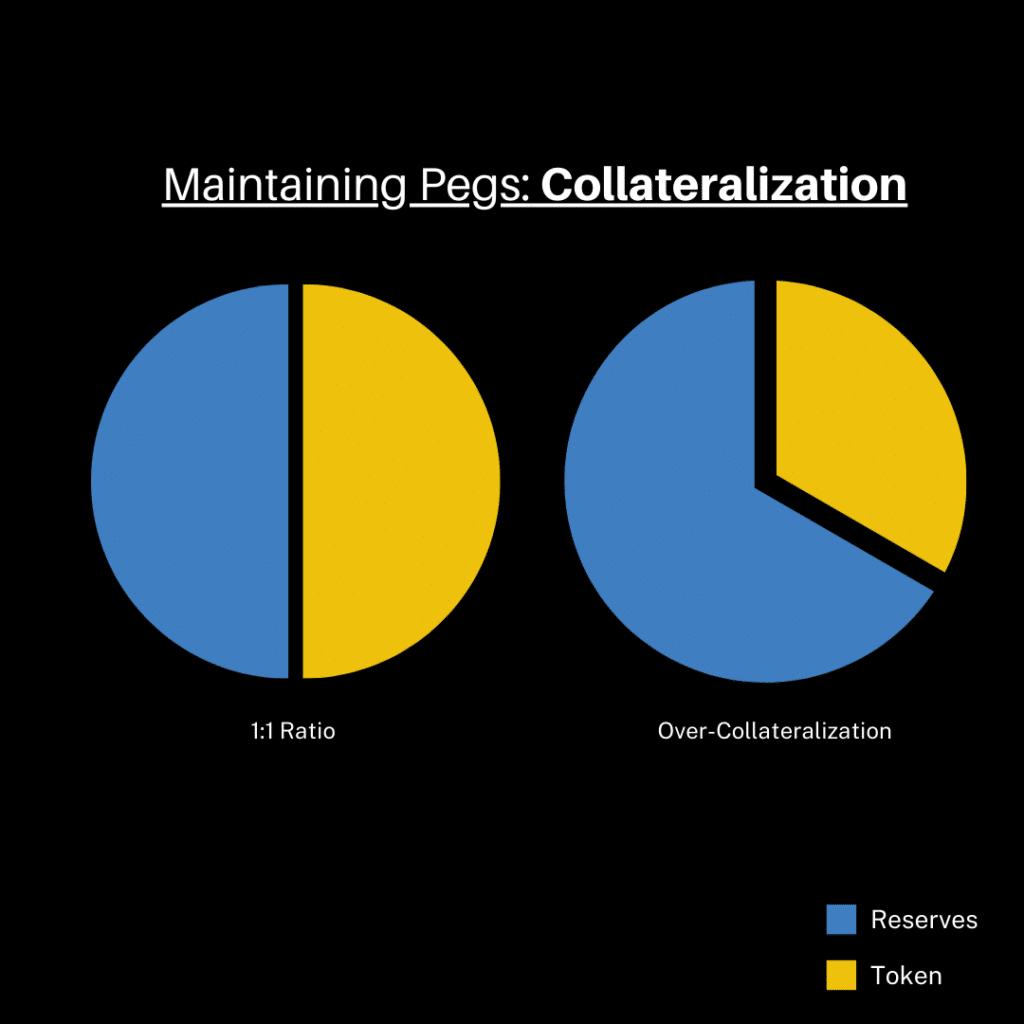What is a Peg?
A peg is a tool that fixes the price of a crypto asset to a particular value.
The Long Definition
A peg is a monetary policy tool that allows a crypto coin or token’s value to be fixed to that of another asset, currency, or commodity. Pegging in crypto is the act of linking the value of an asset to a specific price.
Crypto has its share of pegged assets (those that use pegs). There are stablecoins, like DAI by the Maker Protocol and USDT by Tether, which are pegged to the dollar ($1).
There are also wrapped assets like Wrapped Ethereum (wETH) and Wrapped Bitcoin (wBTC). These are pegged to Ether (ETH) and Bitcoin (BTC), respectively.

History of Pegging
Pegging has its roots in traditional finance. Historically, different countries have different economic strengths, which are represented in their currencies. Countries with weaker economies tend to have more volatile currencies. This puts them at a disadvantage when it comes to international trade.
As a result, some weaker currencies opted to establish a peg with a stronger currency. This involves fixing the exchange rate within a certain range in order to reduce volatility. For example, in 1983, the Hong Kong dollar was pegged to the U.S. dollar. This peg has lasted to date.
This idea would eventually find its way to the crypto space in the 2010s. It culminated in the creation of stablecoins.
Why Do Pegs Matter?
Traditionally, crypto assets have had one key characteristic– they are volatile. The value of crypto coins and tokens can change dramatically. This may work for traders and investors looking to turn a profit. But for people who want to pay for or receive payments for goods and services using digital currencies, it is a huge problem.
For example, if you sell a service worth $500 and receive payment in Ether (ETH), how sure are you that the ETH will be worth the same tomorrow? Of course, it could increase in value up to $700, which means more profits. But equally possible, it could drop to $200, resulting in a loss.

Such uncertainty in value is horrible for most businesses. The preferred situation would be where the value of the payment medium remains stable for a long time.
This is where pegs come in. A peg fixes the value of a digital currency to that of a more stable asset. This other stable asset can be a national currency, like the dollar or euro. It can also be a commodity like gold or silver. As a consequence of being pegged to such an asset, the digital currency attains some stability in value.
For example, crypto tokens pegged to the dollar will always be worth $1. Examples are DAI, USDT, BUSD, and FRAX. Similarly, tokens pegged to the euro will always be worth €1.
Overall, such crypto assets are known as stablecoins. This is because they’re able to maintain a stable value for a long time.
Soft Peg vs. Hard Peg
Pegs can be classified as hard or soft. This classification depends on how flexible the asset’s value is.
A soft peg allows for some level of flexibility in the value of the crypto coin/token. The asset’s price is allowed to fluctuate within a specific range. However, if there’s extreme price movement that threatens to push the asset outside this range, the issuer of the tokens intervenes.
On the other hand, a hard peg doesn’t allow for any flexibility. The asset maintains a fixed exchange rate at all times. If it deviates even slightly, there will be an intervention by the issuer.
Most stablecoins pegged to national currencies use a hard peg. So, how do they do it?

How Stablecoins Maintain Their Pegs
Stablecoins are typically issued by a centralized issuer. For example, USDT is issued by Tether and BUSD by the centralized exchange Binance. There are also stablecoins issued by decentralized protocols, like DAI by Maker.
Whatever the case, the issuer is responsible for maintaining their stablecoin’s peg. They do so by applying monetary policies in response to changing market conditions. This is the intervention mentioned above.
Note that these monetary tools don’t just kick in when the price falls below the peg/accepted range. It’s just as undesirable when the price of an asset rises above the peg as it is when it falls below. For example, Tether will have to stabilize its token if it rises to $1.03, just like they would if it dropped to $ 0.97
Stablecoin Tools
The tools used by stablecoins to maintain their pegs include;
- Collateralization: This involves backing the stablecoin with the stable asset it’s pegged to. For example, Tether has dollar reserves for USDT. Similarly, Maker has Ether (ETH) reserves for their DAI reserves.

Under collateralization, the supply of a stablecoin in the market depends on the size of its reserves. Some issuers maintain a 1:1 ratio– for every $1 token, there is $1 worth of reserves. Others are overcollateralized. This means there are more reserves than stablecoin.
- Algorithmic mechanisms: Some stablecoins aren’t fully collateralized. This means that the reserves aren’t worth as much as the tokens in circulation. So, to make up for the difference, they use algorithms to adjust the supply and maintain their peg.
This is implemented as a mint-and-burn mechanism, where tokens are burnt or minted depending on the value relative to the peg.
If the price of the asset falls below the peg, the algorithm will burn tokens to reduce their supply and raise the price. On the other hand, if the price rises above the peg, the algorithm will mint more tokens to increase the supply and lower the price.
The specific way an issuer goes about implementing its monetary policies varies. For example, Maker is a decentralized protocol. Therefore, the community needs to be involved in major decisions. In this case, members have to vote before the collateralization ratio is adjusted.
Things are different in centralized protocols. Monetary policy decisions are typically made by a few executives.
In platforms that use algorithms, the rules are baked into code. This involves writing smart contracts. Therefore, supply changes happen automatically when certain conditions are met. Human involvement is little to none.
Want to join the Dypto journey? Follow our socials!